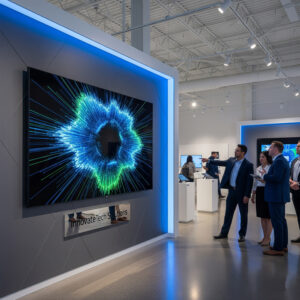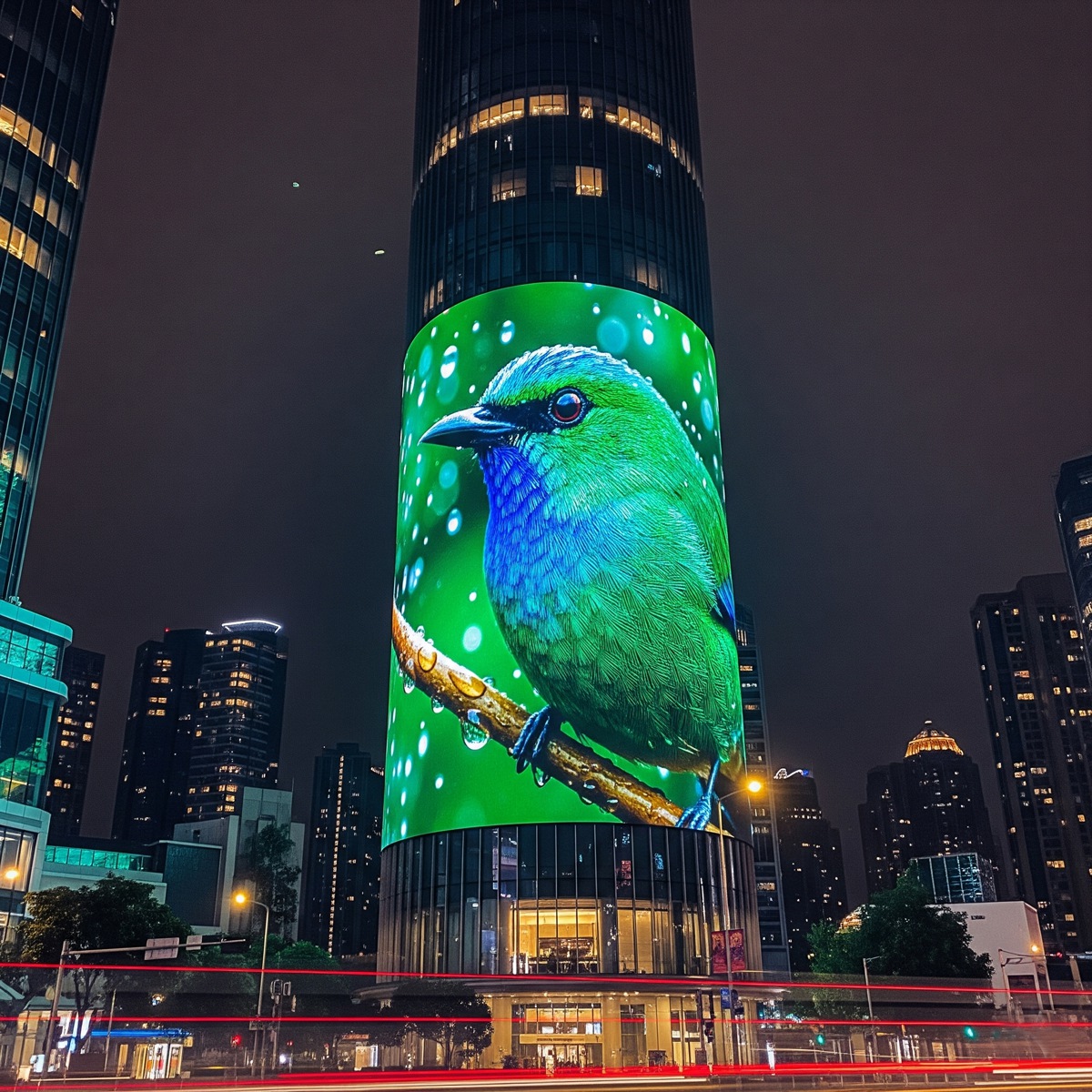
28-meter-high outdoor LED display requires thicker support beams.
En una época dominada por la comunicación visual, light has become more than a medium of illumination—it is a language of emotion. From city centers to retail malls and exhibition halls, brands are turning to immersive LED advertising displays to capture attention in ways traditional screens no longer can. These dynamic installations do more than broadcast advertisements; they build experiences, evoke emotion, and transform architectural environments into living canvases.
The rise of immersive LED environments represents a new convergence of art, design, and data-driven storytelling. As digital interaction becomes central to modern life, these luminous spaces are redefining how audiences perceive brands, products, and even physical space itself.
The Shift from Passive Viewing to Active Experience
Traditional advertising once relied on repetition and reach. Billboards, posters, and static signage delivered information but rarely evoked deep engagement. In contrast, immersive LED advertising displays operate on the principle of sensory connection. By surrounding the viewer with synchronized light, color, and motion, they create a visceral sense of participation.
This transformation mirrors broader cultural trends. Modern audiences, particularly younger demographics, value experiences over possessions. They seek authenticity, emotion, and interaction. Consequently, brands that use immersive displays can foster a stronger emotional bond—turning passive viewers into active participants in their visual narrative.
In retail settings, for example, immersive LED walls enable customers to explore virtual landscapes or feel the atmosphere of a brand’s identity. Whether simulating ocean waves, a city skyline, or an abstract color symphony, light becomes a universal emotional trigger.
Technology Behind Immersion: Precision and Flexibility
At the heart of this revolution lies technological sophistication. Immersive LED advertising displays depend on ultra-fine pixel pitch technology, real-time content management, and seamless modular integration. These systems use millions of individually controlled diodes, each capable of producing a vast range of colors and brightness levels.
Advancements in LED processing have also improved uniformity and contrast, allowing content to maintain visual fidelity even under intense ambient lighting. The result is a display environment capable of conveying subtle emotional tones—whether a warm sunset hue or a dynamic kinetic pattern simulating motion.
Moreover, flexible LED panels have expanded creative possibilities. Architects and designers can now shape displays into curves, ceilings, or 360° panoramic environments. This adaptability allows brands to integrate LED seamlessly into interior architecture, creating continuity between structure and storytelling.

Indoor Museum LED Display
Emotional Design: Turning Light into Storytelling
Light interacts directly with human psychology. Colors and brightness influence mood, perception, and behavior. By understanding this interplay, designers of immersive LED advertising displays transform illumination into an emotional narrative.
Warm tones often convey comfort and intimacy, while cooler hues evoke sophistication or futuristic energy. Dynamic transitions, rhythmically synchronized with sound, can simulate natural motion—such as flowing water or a heartbeat—enhancing the emotional impact of an advertisement.
For instance, an automotive brand might use red and white gradients to symbolize speed and precision, while a luxury watch company could adopt slow, pulsating gold tones to convey timelessness. In both cases, the light composition acts as a silent storyteller, guiding the viewer’s emotional journey.
Interactivity and Data Integration: Personalizing the Experience
The next phase of immersive advertising involves intelligence. Muchos immersive LED advertising displays now integrate motion sensors, AI-driven analytics, and IoT connectivity. These systems can detect audience proximity, gestures, and demographics to adapt visuals in real time.
For example, a display might shift its tone and message depending on crowd density or time of day. In a shopping mall, it can showcase different content when it detects families, young professionals, or tourists. By merging interactivity with data, brands create personalized experiences that feel alive and responsive.
Moreover, with real-time analytics, marketers gain insights into engagement duration, dwell time, and conversion impact. This fusion of art and data ensures that every second of illumination delivers measurable value.
From Urban Spaces to Retail Interiors: Expanding Application Frontiers
The versatility of immersive LED advertising displays has accelerated their adoption across multiple industries. In urban centers, large-format LED façades have transformed architecture into media platforms. Buildings become dynamic art pieces, displaying seasonal campaigns or cultural content.
In transportation hubs like airports and subways, immersive corridors guide passenger flow while offering branded experiences. In retail, flagship stores use floor-to-ceiling LED walls to create “digital runways” or interactive storytelling zones. Even the hospitality and real estate sectors employ LED integration to enhance ambience and showcase lifestyle narratives.
Museums and entertainment venues have also embraced immersive LED as a tool for education and engagement. Through synchronized projection, visitors can step inside digital recreations of history, art, or science—bridging the gap between imagination and reality.
Sustainability and Efficiency: The Green Side of Illumination
Contrary to the perception that high-tech displays consume excessive power, modern LED systems are remarkably energy-efficient. Compared with traditional neon or LCD signage, immersive LED advertising displays consume significantly less electricity while offering a longer lifespan and minimal maintenance.
Furthermore, innovations in power management, automatic brightness adjustment, and recyclable materials have made LED advertising more sustainable. As cities and corporations commit to carbon reduction goals, LED-based media architecture aligns perfectly with the vision of green, smart urban infrastructure.
Challenges and Design Considerations
While the potential is vast, creating effective immersive environments requires a multidisciplinary approach. Designers must balance artistic ambition with technical feasibility, ensuring that pixel density, refresh rate, and color uniformity align with the intended experience.
Content development also presents challenges. Immersive environments demand continuous, high-resolution visuals that avoid fatigue or disorientation. Poor synchronization between sound and light can disrupt immersion, reducing the emotional effect. Thus, collaboration among content creators, engineers, and brand strategists is essential.
Maintenance and calibration are equally important. Because immersive LED installations often cover large or irregular surfaces, ensuring consistent brightness and color balance over time requires advanced software calibration tools and scheduled servicing.
The Psychology of Immersion: Why It Works
Humans are inherently drawn to light. In neuroscience, studies show that dynamic visual stimuli trigger higher attention retention and memory encoding. Immersive LED advertising displays leverage this instinctive attraction. By surrounding viewers with coordinated visual cues, they bypass cognitive filters and evoke immediate emotional engagement.
Unlike traditional media, which relies on narrative comprehension, immersive light experiences communicate at a subconscious level. They make viewers feel rather than just see. This psychological dimension makes them especially effective in environments where attention is fragmented—such as shopping malls or busy streets.
The Economic Impact: ROI Through Emotion
Beyond aesthetics, immersion delivers tangible business results. According to recent market analyses, immersive LED installations increase brand recall rates by over 60% compared to static signage. Retailers also report higher foot traffic and longer dwell times in immersive zones.
For advertisers, this means better ROI per display square meter. Because light-based experiences are inherently shareable, they amplify brand exposure across social media. In effect, one investment generates both physical impact and digital visibility.
As advertising competition intensifies, brands recognize that emotional storytelling through immersive media is not an expense—it is a strategic asset.
Conclusión: Lighting the Path of Emotional Connection
The ascent of immersive LED advertising displays marks a profound shift in how technology intersects with human emotion. These displays transform architecture into experience, and light into language. They bridge the digital and physical, the rational and emotional, creating new ways for brands to communicate meaningfully with audiences.
In the coming years, cities will not just be illuminated—they will be alive with emotion, powered by light that speaks to the heart. For creative innovators and forward-thinking brands, embracing immersive LED design is not simply a marketing decision; it is a step toward shaping the future of human-centered visual communication.




